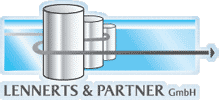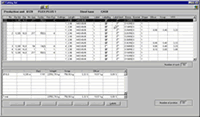Products
LP-System - Technical Part - Optimization Program for Cutting System
Moduls:
- Optimization Program for Cutting System
- Online-Downloading to machines
- Offline-Downloading to machines
- Datasummary
Due to the modular programming method, the bar optimization of various bar cutting systems can be applied.
The bar cutting optimization which is absolutely necessary for the downloading of shearline automates optimizes scrap of material for the actual batch.
The optimization results can be influenced by flexible definition of stock lengths, the definition of bin system, free definable machine parameters (e. g. maximum number of bars that can be pulled in simultaneously each diamter) and information about allowed tolerances. An offcut definition determines the part of contained scrap and offcut.
click to enlarge / example of a cutting list
User can also define whether optimization shall be made drawing or diameter related and whether positions of a drawing should be deposit into a box.
The following criteria are to be considered during optimization:
- flexible requirements for stock lengths
Depending on available inventory lengths, the lengths (freely defined) and the diameters which should be used, can be set for each optimization run. The selection can and should be varied in order to improve optimization.
- definition of the boxes plan
The number of paths as well as the boxes they contain for the machine's filing system, is given for each bar cutting device. The numbering of the boxes can take three different forms (horizontal, vertical and user defined). In addition to this, a maximum length must be set for each box type, so that the system files the individual items correctly in the appropriate boxes. The items which are not to be produced because of their length can then be identified and rejected. If so wished, a certain path may be determined, into which the iron still to be bent can be filed. Otherwise iron which is still to be bent is handled in the same way as straight iron.
- freely definable machine parameters
The user can define the maximum quantity of iron for each diameter, which can be inserted simultaneously. If performance drops as a result of wear and tear of the shears, these values can naturally be adapted according to the circumstances.
To gain an overview of how long the production of items on a cutting list lasts, it is possible to consider specific time data related to the machine (speed of production...). Optionally, if and to what extent tolerances for straight iron and iron to be bent should be included in the optimization, can be stated.
Possible data for the residual lengths causes a breakdown of the cuttings into scraps and remains i.e. the proportion of these appears in the statistics described at a later point, in dependence on this information.
- settings of system parameters
This point represents the core of optimization to the user. He has the opportunity by means of these settings to be made, to considerably influence the execution of the optimization. Alternatively, the user may choose in dependence on the previous production process, whether the items of the various plans, should be worked through according to diameters. That is, whether a plan which has already been begun, should be completed as quickly as possible or as the case may be, successively, for all items of a diameter (naturally with a view to cutting optimization).
In addition to this, the user decides whether the items of a plan should be filed in a box, in order to enable optimization of the work flow.
- Additional characteristics
Graduated lengths are handled differently to all other items during the optimization run. They are filed in a box due to their low number of pieces, amongst other things.
When printing the cuttings list, the user receives statistics about the used stock lengths (number per length and diameter) of the cuttings as well as the computed production times.
The application of bar optimization reduces personnel time at the machine (reduced input, manual optimization), so that with the same amount of work, a higher degree of machine utilization and productivity is attained. The result is that a higher tonnage is produced at lower production costs per tonne.
Previous experience has shown that the application of bar optimization results in an increase of production for the bar cutting system (with machine control) by 30 - 40%.

